
Determine formulary decisions with value-based indicators
What makes the high cost of a drug worth it? Does the intervention have to save a life? Or prevent the onset of a more expensive condition? Or add six months to patient survival? It's all in the eye of the beholder-whether you are a payer, patient or provider.
Sacramento Healthcare Decisions (SHD), a non-profit firm engaging the public in complex healthcare issues, sponsored "Getting Good Value," a project assessing the public's opinion of the role of cost when considering coverage of medical interventions.
About one-third of respondents said they supported coverage of all of the following intervention examples-a medical device costing $30,000 more than a medication that would reduce the number who die from heart disease in five years from 29% to 22%; a quality-of-life medication slowing the progression of Alzheimer's; and a preventive intervention-an annual workup-for early detection of medical problems. Although the "no" responses were more demonstrative in the second and third scenarios, the life-saving intervention only drew support from one-third of respondents.
Marjorie Ginsburg, executive director of SHD, prefers to identify cost-effectiveness as value-based healthcare-is the gain worth the expense? She says that the SHD study shows a willingness to consider value-based assessments but with some conditions: 1) introduce value-based criteria in conjunction with other cost-control strategies; 2) present this strategy as a way of getting the best value for society's dollar and then demonstrate its impact; 3) assure that the value-based strategies do not supersede technological innovations; and 4) make the process credible and transparent.
"A cost-effectiveness analysis is the only way to make hard decisions about how we spend our healthcare dollars," she says. Although, she acknowledges that cost-sharing, limited networks and reduced benefits also play a part in saving costs.
The role of cost-effectiveness analysis in determining which drugs should be included on formulary by insurers is not always transparent or widely accepted, when it is viewed as a means of denying services. Some health plans have turned to the Academy of Managed Care Pharmacy and adopted the organization's Format for Formulary Submissions, which promotes the concept of combining efficacy, safety, effectiveness and economic evaluation for the formulary decision-making process.
COST ANALYSIS-A LAST RESORT?
Keith Bradbury, executive director, drug information for Medco Health Solutions, a pharmacy benefits manager (PBM) in Franklin Lakes, N.J., sees the viability of a cost-effectiveness model-comparison of the relative expenditure (costs) and outcomes (effects) associated with two or more courses of action-when it is applied to two drugs with equal safety, efficacy and side-effect features. "The decision may come down to which drug is less expensive," he says, calling the model "cost minimization."
The change in effects often is measured by the Quality Adjusted Life Year (QALY) that was created to combine the quantity and quality of life. QALYs provide an indication of the benefits gained from a variety of medical procedures in terms of quality of life and survival for the patient.
Most discussions about the value of achieving a QALY put the acceptable cost threshold at $50,000. While QALY may be one way to determine cost-effectiveness, it also begs the question: who should decide what a life is worth? If the cost of treatment is more than $50,000-say for a child born with hemophilia who needs $250,000 of clotting medication-is that child not worth saving?
Newsletter
Get the latest industry news, event updates, and more from Managed healthcare Executive.



















































